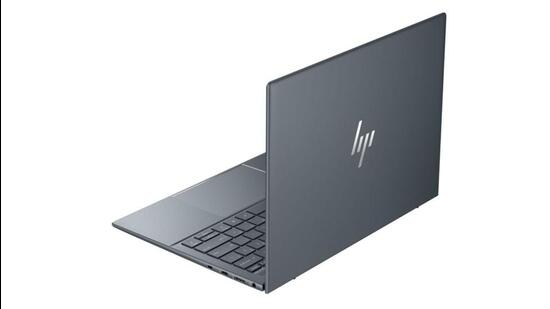Conventional wisdom is often in a sense of conflict. On the one hand, laptops must keep becoming thinner and lighter. On the other, there must be no compromise with performance. Which brings us to the question – how easy is it to balance power consumption and performance, along with the resulting heat generation, into something that works in the real world? There are examples of how PC makers have found this balance. Somewhat, because there’s still a hefty premium dictating the price tags.
HP’s latest generation Dragonfly G4 laptop weighs around 999gm, which is as lightweight as laptops get. Within this ballpark, you’ll find the Lenovo ThinkPad X1 Carbon ( ₹2,04,990 onwards), the current generation Dell XPS 13 Plus (around ₹2,13,990), and even the Lenovo Yoga Slim 7i Carbon ( ₹1,24,990 onwards; notice the 984gm weight), albeit at different price points. That’s an elite category to be in. The Dragonfly G4 that we’re reviewing has a sticker price of ₹2,20,000 with some options for customisation, if you so choose.
The question you need to ask yourself is, how big a premium would you be willing to pay for an ultraportable laptop?
Also read:Lenovo’s new ThinkPad X1 Carbon stays true to its illustrious lineage
The weight reduction doesn’t come from the use of comparatively inferior materials such as a polycarbonate shell. This is a complete metal chassis, and the simple way of reducing weight has been to slice off the bulk that wasn’t necessary. Big bezels around the screen, for instance, gone. Even better, if you get this in the ‘slate blue’ colour.
This is a very compact laptop, clear from the moment you first hold it. Think of an A4 size sheet of paper, this is thereabout. Not much thicker than an ultra-slim document folio either. The connectivity options define the thickness of this laptop, measured 16.4mm – the HDMI port, which will be quite useful to connect with external displays and projectors for presentations as well as a full size USB port for older peripherals such as printers.
There are two USB-C ports, one of which is also used by the power adapter. No memory card slots either. In all likelihood, you’d want to buy a proper USB-C hub system.
Also, a SIM card slot is available on certain configurations, which is good if you need mobile data while travelling. This is a 4G setup though, not 5G.
Also read:HP Spectre x360 16 is a rare big laptop that’s beautiful too, with no rivalry
The screen you’ll be looking at is a 13.5-inch IPS type, which is a modern, square-er take (that’s the 3:2 aspect ratio) on the 13.3-inch laptops that were otherwise commonplace. Something that’s crucial for screens as compact as this is the scaling. On that aspect, HP has tuned this perfectly – you won’t be left squinting or having to come very close to the screen to read certain elements in the interface. It is a bright screen that also handles colours with a generous dose of vividness.
Viewing angles, however, suffer a bit as there is perceptible loss of clarity when you’re not looking at this screen straight on. That’s quite unexpected in this generation of laptop displays.
For ultra-slim laptops, performance is no longer a concern. The Dragonfly G4 we tested runs a 13th generation Intel Core i7 processor with 32GB RAM. You’ll have the 512GB and 1TB storage options as well. This holds performance even with carelessly opened browser tabs and app windows (Google Chrome, Microsoft Edge and work documents tend to be the worst offenders). This is very similar to the sort of responsiveness we noticed with the ThinkPad X1 Carbon as well.
We noticed the HP Dragonfly G4 doesn’t need to dial up the fan speed ever so often, to stay within thermal thresholds.
Most ultra-slim laptops can get fairly vocal about the active cooling system, as you use them. The Lenovo ThinkPad X1 Carbon maintained its poise well, and so does the Dragonfly G4.
Also read:Lenovo Yoga Slim 7i Carbon makes Dell XPS 13 look ridiculously expensive
HP have optimised battery stamina quite well. Even before we got around to deploying aggressive power saving modes from Windows 11’s settings, the Dragonfly G4 returned around 12 and a half hours of runtime on a single charge, as a work laptop with screen brightness around 40%. Do we finally have the consistency and confidence, allowing us to leave the adapter at home?
Remember the question we asked earlier? If you believe it is worth paying ₹2,20,000 for the convenience of extreme portability, there is little doubt the HP Dragonfly G4 delivers on the perception with strong battery life, consistent performance and those nifty value additions that will make a difference as you use this machine. The 5-megapixel (that’s more than standard fare 2-MP cameras) camera for video calls, HP’s own set of apps for managing data security as well as a keyboard that’s accompanied by a fairly large touchpad.
It is quite simply a close call between the Lenovo ThinkPad X1 Carbon and the HP Dragonfly G4, at least as far as the performance is concerned. But there’s a lot more for you to consider. HP has optimised performance enough to eke out more battery stamina. And our preference between the keyboards, among the two, would be HP’s layout over Lenovo’s – the former is just easier to get used to. But Lenovo still has a significant advantage with the ruggedness aspect, thanks to its carbon fiber chassis. It won’t be an easy decision between the two, that’s for sure.

